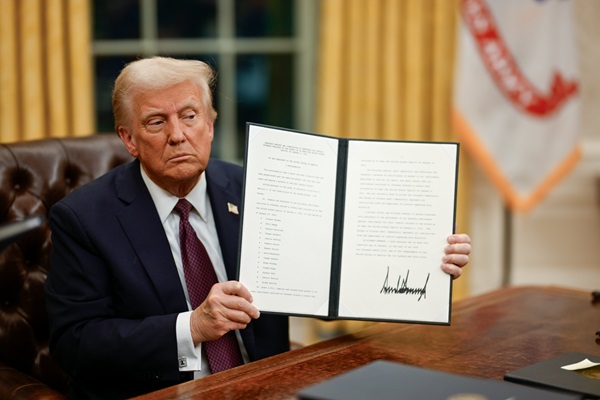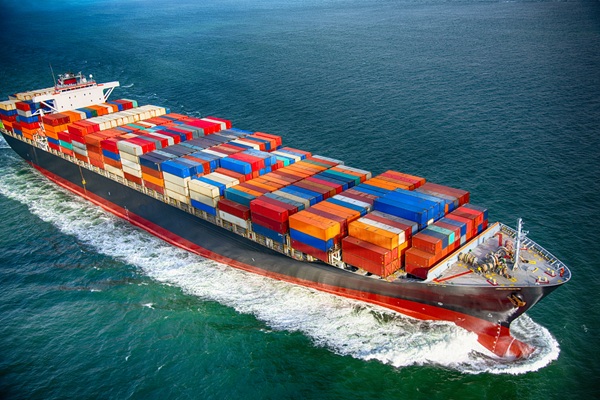.png)
April 7, 2025 at 10:30 AM IST
India is staring at a potential decline of $5.76 billion or 6.4% in exports on account of the reciprocal tariffs imposed by the US earlier this month, according to a study by Global Trade Research Initiative, a New Delhi-based think-tank. US President Donald Trump has imposed a reciprocal tariff of 26% on Indian exports. India exported merchandise exports worth $89.81 billion in 2024.
While exports of seafood, electronics and machinery, gold Jewellery and cut and polished diamonds, automobiles and parts and steel and steel products will suffer major setbacks, sectors like textiles and pharmaceuticals will likely to gain due to competitive pricing and higher tariffs on competitors.
The GTRI’s study is based on assessment of India’s existing export the US, the magnitude of tariff hikes, and the comparative tariffs faced by major competing countries. The study factors in how pivotal the US market is for Indian export category and the extent to which duty-free or lower-tariff competitors—such as Mexico or Canada—could displace Indian goods. Conversely, higher tariffs on other major exporters, like China, could create opportunities for India in select sectors, said Ajay Srivastava, founder of GTRI.
According to the study, electronics and machinery sector is likely to be among the worst hit. Exports of electronics and smartphones are expected to decline by about 12.0%, or $1.7 billion, with Indian exports to the US tending to be low-value-added, GTRI said. India shipped electronics and smartphones worth $14.4 billion to the US in 2024, representing 35.8% of India’s global exports in the segment. The tariff for the sector will rise from the most-favoured nation rate of around 0.4% to 26.7%. India is the fourth-largest supplier of electronics and smartphones to the US behind China, Mexico, and Vietnam.
Exports of machinery and mechanical appliances within electronics and machinery segment is likely to decline by about 2.0%, or $142.1 million. Tariff in the segment will rise to 28.6% from 1.3%. India exported machinery and mechanical appliances worth $7.1 billion to the US in 2024. The US accounts for 21.8% of India’s global exports in the category though India’s foothold is mostly in low- to medium-end products. India may be able to mitigate losses by strengthening global value chain ties with China and ASEAN, the study said.
Gold Jewellery and cut and polished diamonds is another sector, which is likely to be severely affected by the tariffs as limited value addition and the high new duties dampen India’s competitiveness, especially as a significant portion of diamond exports operate on a consignment basis, according to the study. Exports from the segment are expected to fall by 15.3%, or about $1.8 billion. Exports from the segment to the US were $11.9 billion in 2024. The tariff for the segment will jump from 2.1% to 30.2%. The US accounts for 40% of India’s global exports in the segment.
Exports of steel and steel products will also get hit by the new tariffs. With tariffs for iron and steel jumping from 0.5% to 21.6%, the exports are projected to decline 18.3% or $89.3 million, the study said. Exports of steel products like pipes and fittings are likely to decline 18%, or $509.4 million, as Canada and Mexico will benefit from duty-free access under the US-Mexico-Cananda Agreement.
Tariffs for steel products has risen to 29.3% from 1.7%. India exported steel products worth $2.83 billion to the US in 2024.
Another segment, which will be affected by the new tariffs are automobiles and auto parts. Holding just a 0.72% share of the US market, India is severely disadvantaged compared to Mexico and Canada, which have duty-free access. Exports are likely drop by 12.1%, or around $339.4 million, as tariffs jump from a 1% to 27.4%.
Exports of agriculture and related sectors are also likely to be adversely affected by the new tariffs. With tariffs on seafood increasing from duty-free to 26%, exports may fall by 20.2% or $404.3 million, the study said. India exported $2 billion worth of frozen fish and shrimp to the US, accounting for about one-third of India’s global seafood exports. Exports of processed meat and fish products may see a decline of 14.2%, or $83.1 million, with tariffs going from 2.6% to 31.2%.
Exports of coffee, tea, and spices are also likely to fall 13.5%, or $62.2 million, due to stiff competition from Brazil, Colombia, and Switzerland, while cereals exports could see a decline of 12.3%, or $52.6 million, as Canada and Thailand are likely to benefit from more favourable terms.
It is not all losses, some sectors like pharmaceuticals and textiles are likely to gain from the new tariffs, according to the study. India is projected to see modest growth of 2.1%, or $267.3 million, in pharmaceutical exports, primarily driven by generic medicines and active pharmaceutical ingredients. India exported pharmaceuticals worth $12.7 billion to the US in 2024, accounting for 54.5% of its global drug exports. India remains largely unaffected because pharma continues to enjoy zero tariffs. However, Trump has recently threatened to bring pharmaceutical sector under tariffs.
The biggest gainer of the new tariffs is likely to be the textile sector. Despite a sharp increase in tariffs, exports of non-knitted apparel are likely to grow by 2.1%, or $52.9 million, due to competitive pricing and trade shifts away from China and Vietnam. India sold non-knitted apparel worth $2.52 billion to the US in 2024. Exports of knitted apparel is likely to increase by 3.2%, or $77.2 million, driven by supply-chain diversification, the study said.
Exports of textile made-ups are likely to increase by 4.2%, or $130.2 million, reflecting ongoing shifts in sourcing, according to the study.
The study is based on the assumption that all other factors including exchange rates, non-tariff barriers, and global demand, remain constant. It also does not take into account shift in strategies by exporters like adjusting pricing and finding new markets. Also, long-term contracts or strategic partnerships can delay or cushion the immediate effect of tariff hikes, making short-term estimates less precise, GTRI said.




